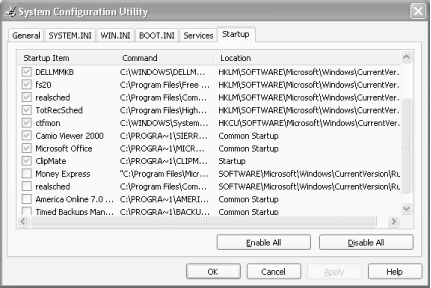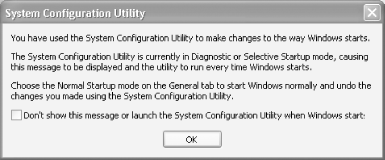Hack 4 Halt Startup Programs and Services
| Increase your PC's performance and speed up startup times by shutting off applications and services that you don't need . One of the best ways to speed up your PC without having to spend money for extra RAM is to stop unnecessary programs and services from running whenever you start your PC. When too many programs and services run automatically every time you start up your system, startup itself takes a long time, and too many programs and services running simultaneously can bog down your CPU and hog your memory. Some programs, such as antivirus software, should run automatically at startup and always run on your computer. But many other programs, such as instant messenger software, serve no purpose by being run at startup. And while you need a variety of background services running on your PC in order for XP to function, there are many unnecessary services that run on startup. For example, on many systems, the Wireless Zero Configuration Service runs to automatically configure a WiFi (802.11) network card, even though no such card is present in the system. 1.5.1 Eliminating Programs that Run at StartupStopping programs from running at startup is a particularly daunting task, because there is no single place you can go to stop them all. Some run because they're put in the Startup folder, others because they're part of logon scripts, others because of Registry settings and so on. But with a little bit of perseverance , you should be able to stop them from running. 1.5.1.1 Cleaning out the Startup folder Start by cleaning out your Startup folder. Find it in C:\Documents and Settings\< User Name >\Start Menu\Programs\Startup, where < User Name> is your Windows logon name. Delete the shortcuts of any programs you don't want to run on startup. As with any shortcuts, when you delete them, you're only deleting the shortcut, not the program itself. (You can also clear out the startup items by going to Start
1.5.1.2 Using the System Configuration UtilityTaking the previous steps will stop the obvious programs from running at startup, but it won't kill them all. The best tool for disabling hidden programs that run on startup is the System Configuration Utility, shown in Figure 1-5. To run it, type msconfig at a command prompt and press Enter. (If that doesn't work, first do a search for msconfig.exe , and then when you find the file, double-click it.) Figure 1-5. The Startup tab of the System Configuration Utility To stop a program from running at startup, go to the Startup tab in this utility and uncheck the box next to the program. It can sometimes be difficult to understand what programs are listed on the Startup tab. Some, such as America Online, are clearly labeled. But often, you'll see a phrase or collection of letters , such as fs20 . That's the name of the running filein this case, fs20.exe , which is Free Surfer mk II, an excellent free popup killer [Hack #33]. As you can see from the picture, I've chosen to let this useful tool run on startup. To get more information about a listing, expand the width of the Command column near the top of the Startup tab. Expand it enough and you'll see the startup command that the program issues, including its location, such as C:\Program Files\Free Surfer\fs20.exe . The directory location should be another hint to help you know the name of the program. When stopping programs from running at startup, it's best to stop them one at a time rather than in groups. You want to make sure that you're not causing any system problems by stopping them. So stop one and restart your PC. If it runs fine, then stop another and restart. Continue doing this until you've cleared all the programs you don't want to run automatically. Each time you uncheck a box and restart your PC, you'll get a warning, shown in Figure 1-6, that you've used the System Configuration Utility to disable a program from starting automatically. If you don't want to see that warning, disable it by checking the box in the dialog itself. Figure 1-6. Disabled program warning After you've used the System Configuration Utility to identify programs that run on startup, you may want to try disabling them from with the programs themselves . So run each program that starts automatically, and see if you can find a setting that allow you to halt it from running on startup. 1.5.1.3 Using the Registry to halt programs running on startupEven the System Configuration Utility won't necessarily let you identify and kill all programs that run on startup. You may also need to hack the Registry to disable them. To do so, run the Registry Editor [Hack #68] and go to HKEY_CURRENT_USER\Software\Microsoft\Windows\CurrentVersion\Run . The right pane will contain a list of some of the programs that automatically run at startup. The Data field tells you the path and name of the executable so that you can determine what each program is. Right-click on any program you don't want to run, and choose Delete. That will kill any programs that run specific to your logon. To kill programs that run for every user of the system, go to HKEY_LOCAL_MACHINE\SOFTWARE\Microsoft\Windows\CurrentVersion\Run and follow the same instructions for deleting other programs you don't want to run at startup. 1.5.2 Disabling Services that Run at StartupConstantly running in the background of XP are servicesprocesses that help the operating system run, or that provide support to applications. Many of these services launch automatically at startup. While you need many of them, there are also many that aren't required and that can slow your system down when they run in the background. You can disable services at startup by using the System Configuration Utility, similar to the way that you halt programs from running at startup, except that you use the Services tab instead of the Startup tab. But the System Configuration Utility doesn't necessarily list every service that launches on startup. A bigger problem is that disabling services is more of shot in the dark than disabling programs. When you disable a program, you can get a sense of what the program does. But when you disable a service through the System Configuration Utility, there's often no way to know what it does. A better way of disabling services at startup is via the Services Computer Management Console, shown in Figure 1-7. Run it by typing services.msc at the command prompt. The Services Computer Management Console includes a description of all services, so that you can know ahead of time whether a particular service is one you want to turn off. It also lets you pause the service, so that you can test out your machine with the service off to see whether it's needed or not. Figure 1-7. The Services Computer Management Console After you run the console, click on the Extended tab. This view will show you a description of each service in the left pane when you highlight the service. The Startup Type column shows you which services launch on startupany services with "Automatic" in that column. Click on that column to sort together all the services that automatically launch on startup. Then highlight each of those services and read the descriptions. When you find a service you want to disable, right-click on it and choose Properties. In the Properties dialog box that appears, choose Manual from the "Startup type" drop-down list. The service won't start automatically from now on, but you can start it manually via the console. If you want the service disabled so that it can't be run, choose Disabled. To test the effects of turning off the service, turn off any services that you don't want to run by clicking "Stop the service" in the left pane, or by right-clicking on the service and choosing Stop. Table 1-2 lists some common services you might want to halt from running at startup. Table 1-2. Services you might want to turn off
|
EAN: 2147483647
Pages: 166
 Programs
Programs 